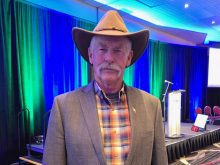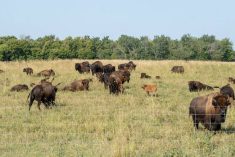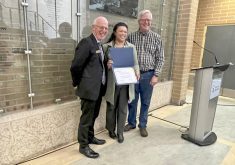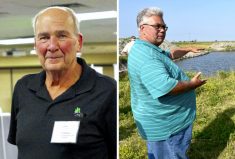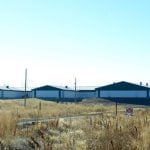The Manitoba Forage and Grassland Association has three more names to hang on its wall of honour.
Michael Thiele, Mae Elsinger and Henry Nelson are the newest faces on the association’s wall of fame, the MFGA announced during its Nov. 14-15 regenerative agriculture conference in Brandon.
Board chair Lawrence Knockaert said the three were chosen for either their work on grasslands or their role in “bringing us to where we are now,” during the early days of the association.
Read Also
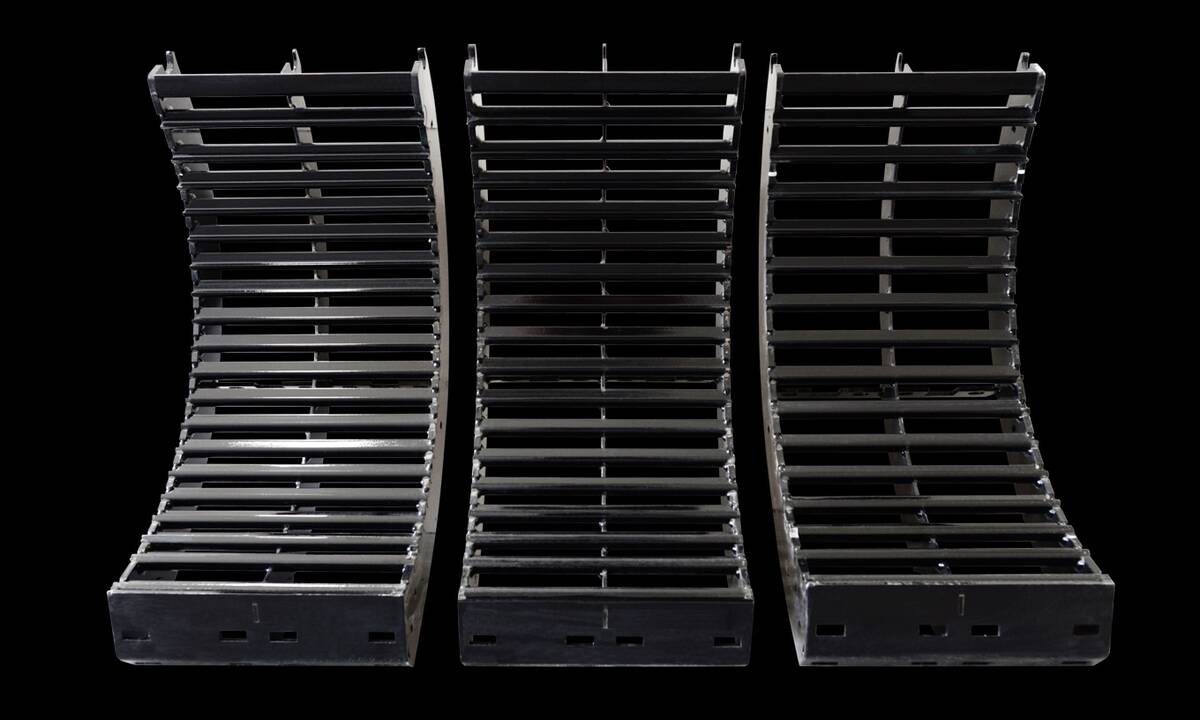
MANITOBA AG DAYS 2026: Stacked equipment category expected at Innovation Showcase
Ten of 28 Innovation Showcase entries at the Manitoba Ag Days 2026 farm show Jan. 20-22 in Brandon are in the equipment category.
“We wouldn’t be here without them…It’s sort of like we’re paying homage to them,” he said.
This is the second year in which the MFGA singled out long-time members or contributors for the mark they’ve left on the organization or the province’s forage and grassland acres.
Leading the way
Henry Nelson has been a pillar of the association for almost 15 years, said the MFGA. The retired agrologist joined the association board in 2008, where he represented the sheep sector. He later served for several years as vice-president.
Nelson’s work on the board was augmented by his history in different corners of the ag sector. His resume spanned the crop and livestock sectors and the public and private spheres.
A former employee of the University of Manitoba, Nelson’s history also included work with Monsanto, the provincial agriculture department – where he specialized in weeds – and crop insurance. His work involved financial mediation, foreign ownership of farmland and sustainable agriculture.
“He’s been instrumental in pushing forage and grasses,” Knockaert said.

On the MFGA board, Nelson helped blaze a trail for the Aquanty project, an initiative that is now a major driver for the association. The hydrological modeling project promised to mimic water flows across five interconnected models of the Assiniboine River Basin, drawing on ground mapping and other data. Scenarios could then be layered onto the model to gauge the impact of different policy or projects.
A real-time hydrological forecasting tool is next in the works for Aquanty. That phase will allow residents to anticipate water flows in a specific area.
[RELATED] Annual forages best in dry years
Nelson co-chaired the project’s steering committee through its first phases from 2015 to 2018.
Today’s MFGA board also credits Nelson for helping secure funds for the organization, for his work toward putting a dollar amount to ecological goods and services, and for being a driving force for the Canadian Forage and Grassland Association.
His work with the MFGA’s national counterpart included a look at forage insurance, a stint co-chairing the environment committee, collaboration with the North American Commission on Environmental Cooperation and spearheading the association’s leadership award.
Government contribution
Mae Elsinger’s history with the MFGA predates the organization as it is now known. A rangeland biologist with Agriculture and Agri-Food Canada, Elsinger’s name first appeared in collaboration with the MFGA’s predecessor, the Manitoba Forage Council.
Three years of field data went into the Native Pasture Improvement Project under that organization, and Elsinger later put her name to the brush monitoring chapter of the MFC’s Guide to Integrated Brush Management.
[RELATED] VIDEO: What does a healthy pasture look like?
She also contributed to forage benchmarking efforts with the forage council. That project drew on forage production data from 12 Crown land leases from 2004-2010.
“I’m still, to this day, being asked for that kind of data,” said Elsinger. “The researchers and other people in the industry – producer groups – they’re still asking us for that forage productivity data.”

From 2010 to 2017, Elsinger’s name appeared among the list of contractors and federal and provincial ag department staff involved in the Manitoba Rangeland and Pasture Health Initiative, under the renamed MFGA. That project yielded a rangeland classification document, pasture health assessment workbook, eco-site map for southwestern Manitoba and eco-region map for two regions of Westman.
In 2014, Elsinger joined the board of the MFGA as a non-voting member representing AAFC.
More recently, the MFGA’s Kirkella Community Pasture Grassland Enhancement Project benefitted from Elsinger’s expertise. The researcher collected pasture data on the site in 2019, followed by a list of recommendations to improve forage production.
Elsinger has also been tapped for projects and field tours hosted by the Manitoba Beef and Forage Initiatives, a demonstration farm with two sites north of Brandon and near Brookdale, She was one of the researchers who studied leafy spurge management at the site. The demonstration farm draws support from various public and industry groups, including the MFGA.
Outside of the MFGA, Elsinger has been involved with Living Labs Eastern Prairies, the Manitoba branch of a federal initiative showcasing innovative farm management projects on a network of farms across the country.
She described her nomination as “unexpected.”
“I think it’s a nice honour. It’s like a lighthouse that tells me that I’m doing good stuff.”
Peer-to-peer
For Michael Thiele, outreach to farmers and advocacy for regenerative agriculture put him on this year’s wall of fame.
As one moderator put it during the Brandon conference, Thiele has been everywhere.
He grew up on a farm near Riding Mountain National Park and started his career in conservation after graduating university. His early career included stints with Farming for Tomorrow, the Manitoba Habitat Heritage Corporation, Delta Waterfowl Foundation, Ducks Unlimited Canada and Manitoba’s network of conservation districts.
“I just worked with all the different groups kind of part time,” he said, “always just sort of asking the question, ‘why are we doing this? Can we do it a little bit better?’” he said.

Eventually, his work roles brought him toward forages, grazing and winter cereals; common tools in the regenerative agriculture toolbox. Thiele began to embrace the regenerative philosophy toward farming, which took its cues from the natural state of grasslands, including biodiversity, quick intense grazing of large ruminants and as maintaining vegetative cover.
[RELATED] Regenerative ag takes soils off life support
Many know him as an organizing force behind the Ducks Unlimited Canada Grazing Club, where Thiele spent two decades promoting forage and pasture management in southwestern Manitoba. Field tours, seminars and workshops throughout the region have consistently featured him as both an organizer and presenter.
Thiele said he is proud of the connections built through those kinds of farmer-to-farmer events. Through the grazing club, he has watched the spread of a “community of farmers that are now kind of learning and growing and sharing.”
He has seen attendees of the grazing clubs branch into other programs that work with farmers on soil health, carbon sequestration and holistic management.
It is in that vein that several dozen farms in Saskatchewan and Manitoba might also know him as their coach.
Thiele was one of the regenerative ag experts tapped by General Mills for its on-farm promotion of holistic management in February 2019. A total 45 farmers were chosen for three years of holistic management coaching through that program.
“That started to happen, which was wonderful because it got me kind of back into nuts-and-bolts ag,” Thiele said.
Today, he is also a consultant for regenerative agriculture firm Understanding Ag.
“You think about it like, what could be the ultimate goal of a farmer? To be able to say at the end of the career, I made a living, I raised a family, I grew good food and I took care of the resources. I made my land better. What could be more rewarding than that?” he said.
“The problem is that we can’t necessarily say that today. What I’ve come to understand is that most of these problems that we talk about, whatever it is – degraded soil or climate change or go down the list – it’s a lack of understanding. They become educational problems and only through deeper understanding can we make change.”
Second round
The three honourees are the second group named to the wall of fame. The MFGA launched the initiative last year “to help celebrate our organization’s history and showcase the exemplary contributions of persons who went above and beyond to ensure our organization’s place in Manitoba,” and to “position MFGA as a well-regarded and well-respected producer-led organization among Manitoba’s agriculture groups.”
This year’s cohort was unanimously approved, the association said.
The MFGA collects nominations through conversations and board meetings, and current board members and staff are not eligible to be named.
In 2021, the association named five inaugural inductees: farmer, former Nuffield scholar and former MFGA board member Ryan Boyd; Ken Gross of Ducks Unlimited Canada; Manitoba Agriculture livestock specialist Pam Iwanchysko; former MFGA chair Dave Koslowsky and Fraser Stewart, former provincial forage specialist and executive director of the MFC.




